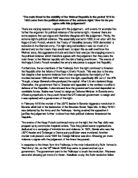The main threat to the stability of the Weimar Republic in the period 1919 to 1923 came from the political violence of the extreme right. How far do you agree with this statement?
“The main threat to the stability of the Weimar Republic in the period 1919 to 1923 came from the political violence of the extreme right.” How far do you agree with this statement?
The Weimar Republic was faced with such adversity when it came to power that it seemed as though it was almost doomed to fail. It had inherited a political situation that seemed untenable due to the abdication of the Kaiser, the signing of the Treaty of Versailles and the “Stab in the Back” myth perpetuated by the old elites of German society. The new government faced violent opposition from both sides of the political spectrum, albeit with differing levels of success, and an economy that was totally out of control. Ultimately however, it was the violence of the extreme right which posed the largest risk to the stability of the Weimar Republic due to its effectiveness and its immediacy.
Firstly, it is clear to see that the violence of the extreme right was indeed a clear threat to the Weimar republic as it in fact managed to succeed in briefly overthrowing the government. Between the years 1919-22 of the 376 political murders carried out, 354 were carried out by right wing activists including the murders of such high ranking figures as Matthias Erzberger, the finance minister, for having signed the armistice and Karl Gareis, leader of the USPD for being a committed socialist. These figures and examples demonstrate two things to us, that the right wing was clearly a threat to the republic as not only were they responsible for the assassination of a huge number of politicians but it would seem that nobody was safe from them, no member of the republic was high profile enough to be safe. These figures also point out how little of a threat the far left was by comparison; the far left was responsible for only 22 of the 376 murders in those 3 years showing that there was definitely a clear gulf in the threat that the two extremes posed to the stability of the republic. This situation was exacerbated as the far right was able to commit these crimes and be allowed to carry on due to the allegiance of the judiciary of Germany. The judiciary was made up of men who remained aligned to the views of the right and were typically anti-republican and anti-treaty of Versailles; due to this they would often be lenient to the defendants on the right wing. This meant that the right wing proved an even greater threat to the stability of the Weimar Republic as not only could they engage in violent activities against the state but they were not punished for doing so, only one defendant out of 755 engaged in the Kapp Putsch was punished and Adolf Hitler was punished with only five years in prison for his part in the Munich Beer Hall Putsch despite charges of treason. The clearest evidence that the Right-Wing was a huge threat to the stability of the Weimar Republic is that in the Kapp Putsch it actually managed to overthrow the government and install a new, right-wing government. In 1920, Wolfgang Kapp, leader of the right-wing, Fatherland Party led 12,000 troops alongside General Luttwitz on Berlin, managing to oust the Weimar government as no government troops opposed the movement. Not only does this show us that the Right-Wing were the greatest threat to the Weimar Republic due to the support they held but also because it gives us an example of them fully ousting the legitimate government, albeit for only a few days. While there is clearly overwhelming support for the far-right being the biggest threat to the Weimar Republic there is also evidence of them not posing quite so significant a threat. The Kapp Putsch was dealt with in a number of days due to Ebert influencing the left wing groups such as the SPD to convince the trade unions to call a general strike thus bringing Kapp’s new government to its knees. The right wing may have managed to temporarily overthrow the Weimar Republic but the politicians still managed to prevent a total disaster. The Munich Beer Hall Putsch that followed is further evidence that the far-right was not as powerful as it may seem. In a situation similar to that of the Kapp putsch, right wingers led by Adolf Hitler sought to march from Bavaria on Berlin but this time the rebellion was easily stopped with the police and the army crushing the movement before it could cause any damage. This may be evidence that the far right was not as large a threat as it would seem, however, the evidence is in favour of showing us that the far-right was a huge threat to Weimar Germany as we have seen that it was engaged in political violence on a large scale and was capable of causing the brief collapse of the Republic whilst maintaining the support of powerful sections of society such as the judiciary.







